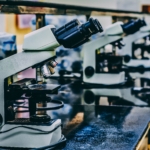
Take a look back at this list of the 10 greatest women in science, technology, engineering, and math.
1. Hypatia
Who? Hypatia’s entry to our list of great women in STEM might appear to some as tenuous. After all, her work was not quite what we would define as STEM today. Hypatia was a prolific polymath in Roman Alexandria. The time and her life are depicted in the film Agora, which is well worth a watch. Hypatia spent her days as a Greek mathematician, astronomer, and philosopher in what is then the Byzantine Empire.
2. Marie Curie
Madam Curie is the only women in history to win two Nobel Prizes. She was awarded both in 1903 and 1911 for her contributions to science. Her work on radioactivity has been of paramount importance to humankind. After her husband’s tragic death, she gained her doctorate in 1903 and took his position as the Professor of General Physics in Sorbonne, Paris in 1906. She was the first woman to hold this position.
3. Rosalind Franklin
Rosalind is best known for her work on X-Ray diffraction images of DNA. Her infamous Photo 51 led to the discovery of the double helix structure by Watson, Crick, and Wilkins in 1962. Watson himself later suggested that she should be awarded the Nobel Prize in Chemistry. Sadly the Nobel Committee has a rule to not make posthumous nominations.
4. Lise Meitner
Lise Meitner was an Austrian-Swedish scientist who worked on the subject of radioactivity and nuclear physics. Meitner and her team first discovered nuclear fission of Uranium when it absorbed an extra neutron. The importance and impact of this discovery cannot be understated. She spent most of her career in Berlin and became the first woman in Germany to become a full professor. Continuing this position got very difficult during the rise of the Nazi party in the 1930s. She ultimately fled to Sweden and became a Swedish citizen.
5. Gertrude B. Elion
This entry on our women in STEM list made some very important discoveries in medicine. Gertrude shared the 1988 Nobel Prize in Physiology with George Hitchings and Sir James Black. She worked alone as well as with her partners to develop a multitude of new drugs, using innovative techniques. These later led to the development of what is known as AIDS drug, AZT. She also developed the first immunosuppressive drug, azathioprine, used for organ transplants.
5. Augusta Ada King-Noel, Countess of Lovelace
This esteemed entry on our list was an English mathematician and writer. She is mainly known for her work on Charles Babbage’s work on a mechanical, general-purpose computer, the Analytical Engine. Her notes include the first algorithm that was intended for the use of the machine. She is, therefore, credited as being the very first computer programmer.
6. Jocelyn Bell Burnell
Jocelyn discovered the first radio pulsars. Sadly excluded from the Nobel prize won by her supervisor Anthony Hewish and Martin Ryle, her work is honored here. Her contribution to the project was to observe and analyze pulsars precisely. Many prominent physicists, including Sir Fred Hoyle, criticized the unfair decision.
7. Barbara McClintock
Barbara was an American scientist and cytogeneticist who won the Nobel Prize in Physiology in 1983. After gaining her Ph.D. in Botany at Cornell University in 1927, she started her career as the leader in the development of maize cytogenetics. Her study of maize allowed her to demonstrate meiosis and the role of telomeres and centromeres on chromosomes. Barbara was recognized as the best in her field, acquired prestigious fellowships and was elected as a member of the National Academy of Sciences in 1944.
8. Chien-Shiung Wu
Wu was an American experimental physicist who made significant contributions to nuclear physics. Wu was a member of the Manhattan project. Her work helped develop the process of separating uranium metal into Uranium-235 and Uranium-238 isotopes by gaseous diffusion. She is most famous for her Wu experiment, which contradicted the law of conservation of parity.
9. Dian Fossey
Dian’s life has been famously depicted in the 1988 film “Gorilla’s in the Mist” which is an adaptation of her book of the same title. Dian’s contribution to zoology, primatology, and anthropology are second to none. Dian spent 18 years studying mountain gorillas in Rwanda. Sadly she was murdered in 1985, a case that is still open.
10. Rachel Carson
Last but by no means least, the great Rachel Carson. Carson is often credited with starting the grassroots environmental movement. She is also credited with the creation of the EPA. Carson was an American marine biologist and conservationist. She began her career as an aquatic biologist for the US Fisheries Bureau and became a full-time writer in the 50s. Her book “Silent Spring” helped lead to the ban on DDT use, inspired the environmental movement and the eventual creation of the U.S. Environmental Protection Agency.
interestingengineering.com







